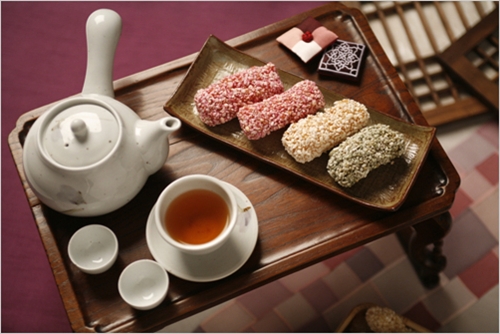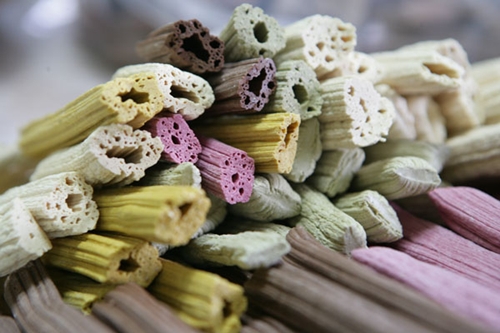담양 한과
Hangwa: a Taste of History
By Kim Su-yeon, Tribune Reporter
At supermarkets in Korea, it is not easy to find hangwa, Korean traditional snacks. As it needs delicate handmade processes and costs high per unit, it is hard to be mass-produced. Another reason that blocks hangwa from becoming popular is in its ingredients. Different from western flour-oriented snacks, it is made from rice and mixed with starch syrup, and dyed using natural colors extracted from wild plants which makes rich, vivid colors. It has a hard texture, but is free of preservatives which make it easy to digest, as a fermented food. In the term hangwa, “han” refers to Korean, and “gwa” means fruits in Korean. More than two thousand years ago, the people who lived in Korea made shapes of fruits with grinded grains in ancestral worship. This became a form of hangwa, and it was further used for tea-time snacks among the noblesse or served at holidays and weddings in private houses. The Chonnam Tribune visited a hangwa factory in Changpyeong, Damyang County which is one of the most famous regions for making the Korean traditional snacks. When Prince Yangnyeong, the first-born son of King Taejeong of the Chosun Dynasty, visited Changpyeong, his maid handed down the recipe of hangwa at court to the residents. As the people of that area came to know about the recipe, the presence of numerous local gentries living in the vicinity diversified the traditional confectionary.

yugwa is fried glutinous rice crackers
Finger-tall tube shaped, yugwa represents hangwa. It is one kind of gangjeong, fried glutinous rice crackers. Since rice was precious, yugwa was usually made in gentry’s families or at court. Especially in Changpyeong, grain syrup is used in making hangwa. Grain syrup gives much sweeter tastes, however it costs twice as much as regular starch syrup. This makes the yugwa from Changpyeong more special. To make the snack, knead glutinous rice soaked in clear water for one or two weeks with grain syrup and chop it into small finger sizes. Then fry it two times which makes yugwa porous, tasting similar to cotton candy. When the Chonnam Tribune visited the factory, making yugwa processing was mostly mechanized to making it same sized. However, it still needed handwork to evenly decorate yugwa.

yeot is a long rectangular shaped sticky candy
Changpyeong is especially known for yeot, a long rectangular shaped sticky candy, which is made from steamed rice and liquid malt. Mixed with malt and boiling the steamed rice makes it becomes a brown sticky liquid. Yeot is usually just cooled and cut in this process, but Changpyeong, it is stretched two times by hand, becoming white. With this stretching, it gets small holes which make Changpyeong Yeot nonstick. Then it is folded to get thick. Due to its tendency to stay stuck; test-takers are given yeot as a goodluck symbol for exams as Korean ‘to stick to an exam’ is the same expression to ‘passing an exam.’ Unlike other hangwa made from rice, yakgwa’s main ingredient is flour. It is a brown round deep-fried honey cookie and is the most popular in Korea. Since it is easy to make, and thanks to the flour that gives a softer texture than rice, yakgwa suits the public taste. Furthermore, the ingredients are fairly simple and it is able to be mass-produced, which is another factor that made it popular. To make it, mixed sifted flour, sesame oil and honey are pressed in a cookie cutter. After that, it is fried at a lower temperature of about 130 Celsius which makes it deep-fried. Before it gets cool, it is soaked in grain syrup until the syrup reaches its center.
In the factory, we interviewed Korean Food Grand Master no.33, Park Sun-ae, expert in hangwa. She said, “Damyang is the origin of the Youngsan River which is one of the four main rivers in Korea. It provides healthy nutrients to the grand plains of Honam.” Like what she said, Changpyeong was a city of clean water and large areas of flat land. Furthermore, the expert uses only regional products in making her hangwa. She said, “It is also important to keep the vein of traditions in hangwa as well as to maintain the recipe and using local ingredients.”
김수연 기자
turc04@hanmail.net

